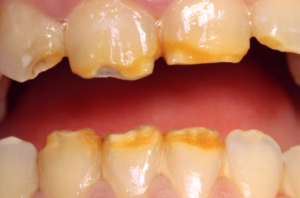Amelogenesis imperfecta is currently classified into 4 main types and 14 subtypes. Each of these types is distinguished as per the dental problems and associated inheritance patterns. The condition may occur as a symptom of some other pre-existing disorder that also cause problems in other areas of the body, or it may affect only the teeth.
In the United States, AI incidence rate is 1 in 14,000 and significantly higher in Sweden at 1 in 700. Teeth function and appearance can be corrected via orthodontic and periodontal surgical restoration.
Symptoms of amelogenesis imperfecta
Amelogenesis imperfecta may cause the below listed signs and symptoms:
- Defective/missing teeth enamel
- Early loss or breakage of teeth
- Increased sensitivity of teeth to temperature changes (heat and cold)
- Abnormal upper and lower jaw alignment may lead to development of an ‘open bite.’
- Tissues present next to affected teeth, such as the gums, cement, ligaments, and alveolar, etc., may be at higher risk to ailments
- The dental pulp present in the root canal may be noticeable in some cases
- Ugly and abnormal look of the teeth may cause psychological problems like low confidence, reduced self-esteem, etc. in patients
Types of amelogenesis imperfecta
The classification of AI is done according to the enamel thickness, clinical appearance, mode of inheritance, and appearance of x-ray negative, etc. The 4 main types of amelogenesis imperfecta are listed below:
- Type I hypomaturation AI: Patients may suffer from small (or normal) teeth tops or crowns; enamel may be thin and smooth, grooved, pitted, or normal; off-white, cream, or yellowish brown teeth color; upper and lower teeth set do not meet which causes a poor bite
- Type II hypomaturation AI: Symptoms include creamy, yellowish brown teeth discoloration, tooth tenderness, open bite, rough surface of teeth, and sore teeth. The thickness of teeth enamel is normal, but it can be brittle or very delicate. It has X-linked traits, or inheritance mode is typically autosomal dominant, or autosomal recessive
- Type III hypocalcified AI: Distinguishing features include tender, sore teeth; open bite; rough surface of enamel; and cream or yellowish brown teeth color. Large quantities of calculi (oral fluids) caused stony precipitates may be seen on the teeth.
- Type IV hypomaturation/hypoplasia/taurodontism AI: People with this type of amelogenesis imperfecta feature smaller, blotchy, patchy, and spotted teeth; yellowish brown or whitish teeth color; thinner than normal enamel with pitted areas or less solid/hypomineralized sections. It has an autosomal dominant inheritance pattern.
Causes
Amelogenesis imperfecta is an inherited condition caused by varied genetic defects. A few causative genetic mutations identified by experts include errors in the genes ENAM, MMP20, AMELX, and FAM83H. About fifty percent of all AI instances are caused by mutations of the above listed genes, and a large chunk of this 50 percent is triggered by FAM83H genetic errors. Studies are currently on to try and find the other kinds of causative genetic mutations of amelogenesis imperfecta.
The genes AMELX, ENAM, and MMP20 provide instructions for making proteins responsible for normal teeth formation. Most of these proteins also contribute towards enamel development. Experts are not aware about the function of protein created by the FAM83H gene, but they believe that it may contribute towards formation of enamel.
The genetic errors alter proteins’ structure or prevent it from being produced. As a result, teeth enamel are thin, softer, and yellowish or brownish hued. Teeth with abnormal enamel are weaker and susceptible to easy breakage.
| Type of amelogenesis imperfecta | Location of mutated gene |
| Type I amelogenesis imperfecta | 3-p22.1, 4q31, Xp22, & Xq22-q28 |
| Type II amelogenesis imperfecta | chromosome 11, 19, & X-chromosome |
| Type III amelogenesis imperfecta | 4q21, 4q21 & X-chromosome |
| Type IV amelogenesis imperfecta | 17q21, 3-q22 |
Mode of inheritance of amelogenesis imperfecta
Amelogenesis imperfecta may have many different patterns of inheritance according to the type of gene that is mutated.
- In most instances, mutations of the MMP20 or ENAM genes have an autosomal recessive pattern of inheritance. This means that AI will form only when 2 mutated copies of the gene are passed from both the parents. The parents themselves may not elicit AI symptoms, but may be carriers of the genetic mutation.
- Mutations of FAM83H gene gets passed on as an autosomal dominant trait. Thus, a single copy of mutated gene is sufficient for the child to develop amelogenesis imperfecta. This inheritance pattern is also observed in some cases of ENAM gene mutations.
- Mutations of AMELX gene feature an X-linked pattern of inheritance in about 5 percent cases of AI. X-linked inheritance pattern means that the error occurs in an X chromosome gene. In this type of inheritance mode, AI tends to be more severe in affected males than females.
- Other AI cases develop due to random genetic errors. They occur in patients with no family history of the condition.
Treatment of amelogenesis imperfecta
Treatment of amelogenesis imperfecta is done according to the type of AI. Some common treatment options are as follows:
- Orthodontic and periodontal repair and restoration to improve teeth appearance and function
- Better dental hygiene practices, like brushing every day, etc., to prevent worsening of dental issues
- Desensitizing toothpaste for easing tooth sensitivity and pain
- Better social and psychological development in affected children with restorative care
- Different kinds of fixed prosthetic and removable procedures for improving smile and facial appearance
- Use of sealants, bonding therapy, and other preventive care methods
- Specialized dentures that cap irregular teeth, restoration of crown, or installation of entire crown for treating open bite


